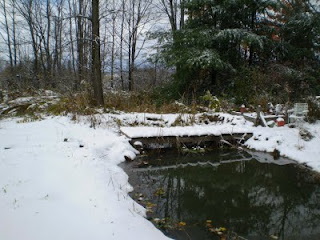
src="http://pagead2.googlesyndication.com/pagead/show_ads.js">
Buckwheat Beats the Snowfall
Buckwheat moves fast. On September 20th, pictured above, is the buckwheat planted August 19th. Buckwheat was simply broadcast on the soil in a raised bed a day after the garlic was harvested. Just amazing.
Buckwheat is often a forgotten crop which can be used by backyard gardeners. It will enrich the soil and helps to control the weeds. This is the first of two raised garlic beds, the other is about a week behind and just starting to bloom.
Late September and into October are great times to plant garlic. This year the bonus might be some extra buckwheat, if not for pancakes, then for the winter bird feeder. Buckwheat will be a garden favorite here, it saves money because less organic fertilizer is needed, saves on the compost, saves time from constant battles with weeds.
Buckwheat could be a good crop to plant after spring lettuce or broccoli crops are gone or just to have a bed or a row or two. It enriches the soil and helps the bees. And the bees will come. The buckwheat is swarming with honeybees and bumblebees; there are so many you can hear the buzz. Buckwheat has to be one of the original bee plants.

Now is the time to face some cold reality. Pictured above is the first snowfall last year and, grab your seat, it was October 29th and about six inches. So even if buckwheat is planted as late as August 19, it is possible to harvest a kitchen crop in about seven weeks, maybe eight. To check the first and last frost dates, click weather service, for your area. It gives a general idea at the very least. Buckwheat planted in August gives the bees their last good meals before winter.
If you want to save some for kitchen use, the hulls come off easily. The remaining kernel, called groat, can be ground into flour, or eaten or used as sprouts. The leaves and the flowers are also edible and can be used in salads or as an herb.
Support Your Local Bookstore:
Buy a book from your independent bookstore by clicking the ad below.
Shop Indie Bookstores
Rosy Red's: The Best Place in Town
The small pond in the snow picture above is the Frog Bog which was dug out last year in September. It sits on the edge of the backyard garden. We put in about a hundred Rosy red minnows, which are actually flathead minnows, but they are a brilliant orange color, very communal and peaceful. They multiply like guppies and love mosquito larvae. Kids and a lot of adults walk through the garden to feed the fish bread, so nobody sees the weeds.

For more information on them, Rosy Red. These small minnows would work well in any size garden pool and they are even great fish for an indoor tank. Even a small water pool in the garden is a great help for birds, butterflies, bees and people.
H1N1 Health Care is a universal human right and the current debate should include all person within the borders. It is the moral course of action and plain common sense. Read more here and leave your comment on what you think.
Keep updated on the H1N1 virus, click the ad below.
For the Heck of It:
What happened to September? The full harvest moon is in a couple days, October 4th.
October is also breast cancer awareness month, be safe.
October is also adopt a shelter dog month. Why not? On that note, here is a great article from Penn State and the research into why and how it might soon be possible to help dogs that are scared of of thunder and lightning storms.

My dog isn't scared of thunder, but let him hear a firecracker or a rifle shot, he's hiding!
Good Blogs to Read
Vincent di Fondi
On Your Way to the Top
New York's Southern Tie
Urban Veggie Garden
Simply Snickers
No comments:
Post a Comment